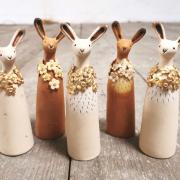Janice James from Greens of Devon shares her top tips for creating a beautiful floral kitchen garden

A sign of summer in the kitchen of Janice James is a bowl of freshly-picked salad. A variety of green leaves will always be interlaced with a scattering of colourful, edible flowers, perhaps orange nasturtiums, blue cornflowers or pink dianthus.
Janice has always grown her own salads. Popular with her own family, and friends too, she started to sell her colourful salad bags to fellow parents in the school playground, and then at market in Exeter.
“When I started selling to local restaurants I realised that although they loved the variety of leaves, having flowers upped the ante, as you couldn’t get them anywhere else.”

It was time for the flowers to take over. Janice launched Greens of Devon in 2008, focusing entirely on edible flowers and herbs. She and partner Ivan had always grown their own veg and fruit, without chemicals, on an allotment in Exeter, but by 2008 they had a plot of land at Silverton where Ivan was setting up a vineyard. This new space gave Janice the chance to grow flowers in profusion, and start selling by mail order to addresses across the country.
One of the keys to Greens’ success is the packaging, as Janice says: “As soon as flowers are picked and open to the air they will dehydrate and wilt.”
So, they invented a heat-sealed box with different sized compartments, allowing for several varieties and sizes of flowers to be sent in one container.

They sell selections of seasonal flowers, along with boxes of larger blooms. Tulips “are a revelation”, their large leaves and range of colours mean they work perfectly as unique canape holders. Another popular flower box is the rose petal collection, or you can buy whole rose heads, which make a fabulous centrepiece for cakes or celebration dishes.
A recent addition is the cocktail collection; herbs and flowers that can be used to make a range of drinks – with accompanying recipes online.

Read more: RHS Garden Rosemoor has reopened after lockdown
Edible flowers are not a new thing, they have been used for decoration and eaten either for taste or medicinally for centuries. “I’d done so much reading and research around the subject, I wanted to know what you could grow, and the different flavours,” says Janice, who has spent years researching edible flowers and herbs.

“The Victorians were doing this way back, it’s an old practice; and foraging for herbal tinctures is all tied up with it as well.”
She adds: “My sister in Northern Ireland ran a nursery for years so we have plenty of plant talks – it’s always been in the family I suppose, it’s shared knowledge.”
This knowledge, and being one of the first to supply edible flowers online, put Janice in good stead with Greens becoming a favoured supplier to big names, such as the BBC MasterChef programme and it also supplies the Great British Bake Off TV series every year.

She puts it down to having the knowledge and being able to give a consistent quality service – buyers must have confidence in the product, she says.
As well as knowing what flowers to pick, for colour, taste and for how they will be used, Janice also recognises the exact moment when it is best to pick them. She needs to be precise with something so delicate. There is a limited time for the best picking. “Flowers can’t have dew on them, or be too hot,” she says. “I could go round and pick things, but I know they won’t last, they have to be in perfect condition. An untrained eye could just pick away, but we are really particular about what we send out and have built up a reputation for quality.”
Despite its success, Greens is still a small family business and it works with the seasons. Flowers are not forced and pushed to bloom and the plants are allowed to die back naturally. They harvest and use their own seed and Janice and Ivan aim to be as sustainable and environmental as possible with their site, including the vineyard.

“We really want to look after the land well and not become a monoculture. We have beehives and grow our veg too, it’s all about giving back and doing your bit.”
Edible floral favourites from Janice

Orange calendula: An ancient medicinal herb, the flowers come in shades of yellow and orange. Sow the seeds March-May and/or August-September under cover or direct into the garden. Keep picking or deadhead to ensure flowers until the first frosts. For stronger plants sow in autumn and over winter. Can be grown in container pots. The petals add a beautiful touch of colour to many dishes.
Peony tulips: Tulip petals have a gorgeous crunch and texture, the flavour reminiscent of pea. Plant bulbs in November when temperatures are lower, to avoid tulip blight; the flowers will appear April/May. A great way to use them is as a stunning canape holder. A family favourite in our household is to fill the individual petals with roasted beetroot, goats’ cheese and dukkah – wonderful party food!

Courgette flowers: One of the easiest and most prolific of summer veg varieties to grow. It’s a hungry plant, so incorporate plenty of organic matter, such as manure and compost into the planting hole and mulch to retain moisture. The flowers can be stuffed and/or tempura battered for a fantastic starter.

Nasturtiums: Possibly the most well-known of all edible flowers, this is a peppery one, available in flamboyant colours and an excellent companion plant for beans and salads. Direct sow seeds May-July and they will start flowering 10-12 weeks later. They flower until the first frosts and taste amazing in salads, couscous, and even cocktails!
Chive flowers: These, along with the other alliums, garlic chives and society garlic, are super easy to grow and loved by pollinators. Once established, the clumps can be split and divided to make more plants. Chives flower in the early half of the year, garlic chives flower late summer into early autumn, so grow both to have a steady flow to the kitchen.
You can follow Greens of Devon on Instagram or check out their website .
Have you joined the Devon Life Facebook page yet?



























